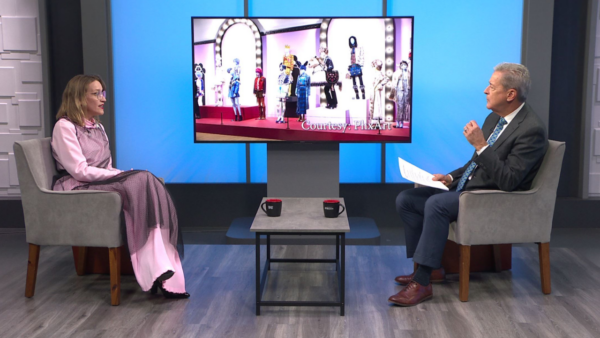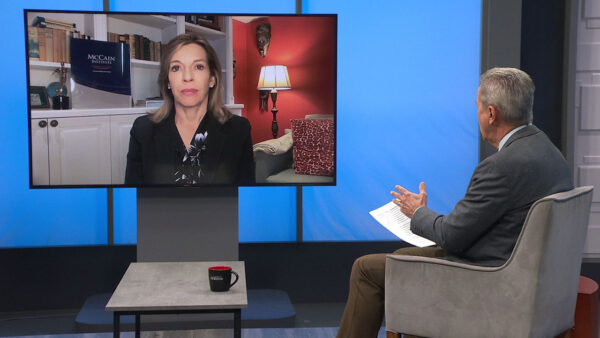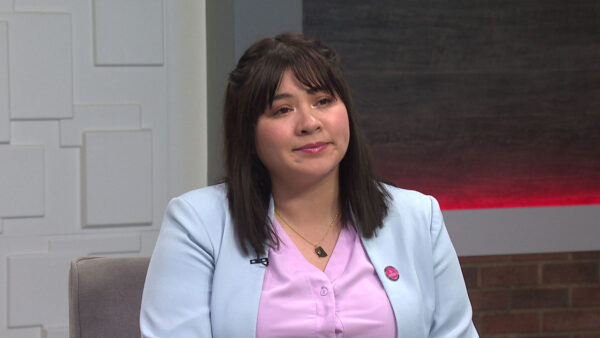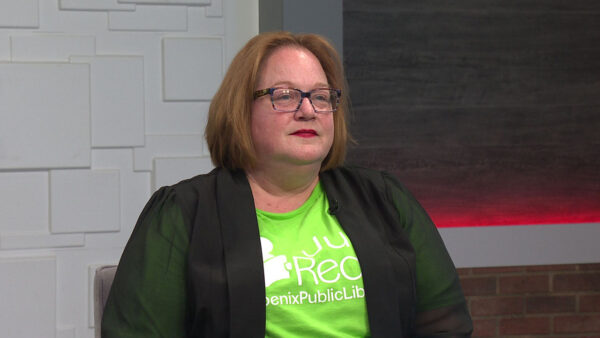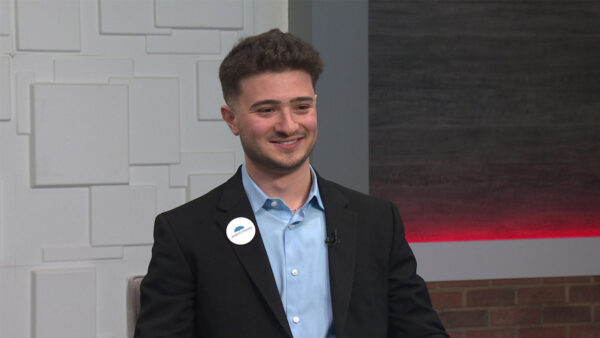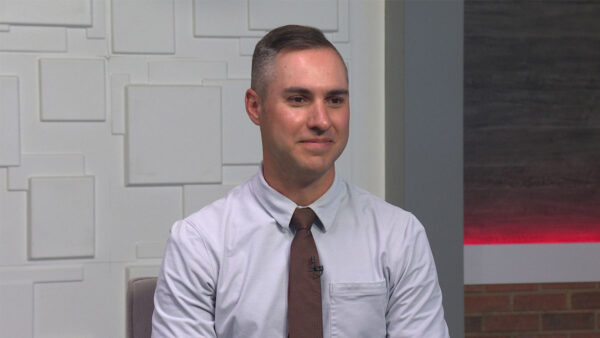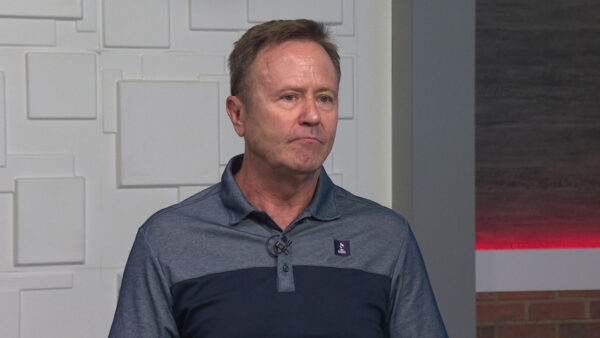The $9.6 Billion budget passed by the state legislature includes a $1.5 million one-year allocation for the Arizona Commission on the Arts to use for grants and programs for nonprofit arts and culture organizations statewide. The current year budget did not have any arts funding and resulted in the loss of a significant number of grants for organizations across Arizona. The 15 members of the Arizona Commission on the Arts will meet in June to decide how to distribute the money. Catherine “Rusty” Foley, executive director of Arizona Citizens for the Arts, and Jaime Dempsey, deputy director of the Arizona Commission on the Arts, will talk about the funding and how it might be spent.
Christina Estes: Coming up next on "Arizona Horizon," hear what the arts community plans to do with new state money. How desalination may help meet Arizona's future water needs.
Video: Finding a new use for old buildings in Phoenix. Those stories and more next on "Arizona Horizon."
Video: "Arizona Horizon" is made possible by contributions from members of PBS, your PBS station. Thank you.
Christina Estes: I'm Christina Estes in for Ted Simons. Arizona Attorney General Mark Brnovich says he will not delay next week's special election but plans to investigate what went wrong in the Secretary of State's office. Secretary Michele Reagan is responsible for overseeing state elections including mailing publicity pamphlets to registered voters. Those pamphlets contain information on two propositions. One deals with public safety pensions the other with education funding, but he says they failed to deliver 200,000 pamphlets far enough in advance of the election. He says he's angry and frustrated but thinks delaying the election now would disenfranchise early voters.
Christina Estes: Arizona's Supreme Court justice wants the governor to veto a bill that would expand the court. In a letter, chief justice Sott Bales says increasing the court from five to seven justices is not needed or warranted when other financial needs are not being met. the sponsor of the bill, J-D Mesnard, says it's needed because of Arizona's population growth. Opponents say it's an attempt by Republicans to stack the court because it would instantly give governor Ducey two new picks.
Christina Estes: In tonight's edition of Arizona Art Beat we look at new funding for the arts. The $9.6 billion budget recently passed includes 1.5 million for the Arizona commission on the arts to be used for grants and programs to support nonprofit arts and culture groups across the state. Here to talk more about how the money might be used is Catherine "Rusty" Foley, executive director of Arizona citizens for the arts, and Jaime Dempsey, deputy director of Arizona commission on the arts. Thank you both for coming in. Before we get to this 1.5 million, talk about how things have been the last couple of years for the commission as far as the economic situation.
Jaime Dempsey: sure. Well, it's been challenging to work with fewer resources, but I think that what has happened at the arts commission has been reflective of what's happening in the rest of the arts sector. Post recession we are leaner, more innovative, and we have become that way out of necessity, but now it's a perfect time for additional investment because we're ready to take the next step with our programming.
Christina Estes: you said your group is the eyes, ears and voice for the nonprofit arts world at the legislature. How did that work for you this year?
Catherine Foley: well, it worked better than it has in recent years for sure. We really mobilized this year because as Jaime says it's time for us to be reinvesting in the arts sector because it has gone through some difficult times and survived remarkably well in terms of the kinds of service and programs and opportunities that it provides to our citizens, but it's time to reinvest and really leverage all of that wonderful work so more citizens have it available to them. So arts and culture can make even greater contributions to our communities.
Christina Estes: the last several years have been tough for a lot of groups. Certainly in the arts world as well. How do you stay passionate and committed and not just throw up your hands?
Catherine Foley: you stay passionate because both Jaime and I are very familiar with the work that arts organizations all over Arizona are doing. When you visit those their you attends performances, you go to their gallery venues. You see the work they are doing in schools with students, you can't help but be inspired. That is indeed what keeps you going.
Christina Estes: Jaime, I have heard your boss say that arts are an economic driver. What does that mean?
Jaime Dempsey: absolutely. The arts are not only an economic driver in communities. The arts activities certainly drive local spending, but the arts are also an opportunity for communities to increase connectedness and civic pride and research shows that community members who participate in arts and culture events are far more involved in other civic activities including volunteering and mentorship.
Christina Estes: why do you think that is?
Jaime Dempsey: I think it's about the arts are central to who we are. They create opportunities and a platform for sharing and learning about each other. That's something I think that's increasingly hard to come by in our -- in the way that our world is so hyper connected. The arts provide us with opportunities to connect with each other one on one, to learn about different cultures, and to feel a pride, sense of pride and sense of place in communities.
Christina Estes: What would you say to somebody who says I'm not the artsy type?
Catherine Foley: well, I hear that a lot. I think what I say to people like that is that I think they don't understand really how much participation they may be engaged in in terms of creative endeavors. You don't have to do art yourself to appreciate music, to appreciate a good play. To want your children to have an opportunity to learn and experience art, to manifest their own creativity. And then as Jaime says, the role that arts play in connecting communities is so important, we want to be talking about what's good in Arizona. We hear that a lot down at the legislature and the governor's office. The arts are one of the things that are really great about Arizona and we want to leverage arts to in terms of how we portray ourselves to the rest of the country, to people who want to come here and start businesses or expand businesses, come here and live, come and spend their money as tourists. So even if you're not an artist yourself, arts are contributing to the health of our communities in ways that are important to all of us.
Christina Estes: Let's talk a little bit about the money. You've got $1.5 million that you didn't have last year. I'm guessing people are hoping for a piece of the pie. What happens now?
Jaime Dempsey: we're thrilled with this outcome. As you said we haven't seen an increase in in funding for several years. We have a robust slate of grant programs that have been over the last few years somewhat under-funded. There are arts organizations and schools and artists and artist collectives and community groups doing extraordinary work across Arizona. We would like to reward that with increased funding. All of the grantees are ready to take the next step with their programming.
Christina Estes: What's the process in place? Do you have people knocking on the door saying, hey, write me a check?
Jaime Dempsey: no, if we come looking for a checkbook, we don't have one. We have several -- our grant programs are reviewed by communal panelists. Our panels are made up of community members, community leaders. We look for geographic diversity and diversity of experience, of age. Our panels are all volunteer. They come many together, review grant applications, review the work of applicants occasionally, then make recommendations to our governor appointed commissioners who ultimately approve the recommendations and make the grants.
Christina Estes: Have you been involved at all in the process of who is going to receive funding?
Catherine Foley: I haven't sat on any grant panels in recent years because of my role at Arizona citizens for the arts, but yes, I have had that opportunity. I would also say our organization sponsors the governor's arts awards. We see nominations from many of the same organizations that are applying for grants to the commission and so we get very familiar with the work that they are doing. As I say, it's really not hyperbole to say it's 'inspiring to see what the organizations are doing. That's the big take-away when you sit on a grant panel or on the awards panel, just hard to believe how good the work is and the diversity and the impact that it's having.
Christina Estes: I can feel it coming from both you guys. I appreciate your passion and both of you coming in and sharing the information. Thank you.
Jaime Dempsey: Thank you.
Catherine Foley: thank you.
Video: Get the inside Scoop on what's happening at Arizona PBS. Become an insider. You'll receive weekly updates on the most anticipated upcoming programs and events. Get the insider delivered to your email inbox. Visit AZPBS.org to sign up today.
Christina Estes: In our look at sustainability issues we'll talk about the idea of using sea water for Arizona's needs. Two years ago Arizona and the state of Sonora, Mexico, signed an agreement to explore the possibility of desalinizing water from the Sea of Cortez. Chuck Cullom, the Colorado River project manager for the Central Arizona project, here to tell us more about desalinization and the possibility of using it to provide water for our state. I can't say desalination again. I'm terrified I'm going to stumble over that. It's a big word. In its simplest terms what does it mean?
Chuck Cullom: it's a process where we take salty water and we strip away the salt and through a membrane process we separate the salt from the fresh water and deliver fresh water to customers. We can take an impaired supply, whether it's slightly salty like brackish ground water or agricultural drainage water or something extremely salty lie the sea of Cortez and the Pacific ocean.
Christina Estes: there are places that have plants a and this is how they get their fresh water. What's the status for Arizona?
Chuck Cullom: It's interesting. Arizona led the nation in 1962 with the first municipal water supply provided solely from a desal plant in Buckeye in 1962. They used electrical dialysis to generate this water supply. Buckeye is still using desal technology today for part of their water supply. As we think about our water supplies in the future, the central Arizona project delivers Colorado river water, and that supply has a rocky future ahead because of prolonged drought on the system and the risk of shortage on the Colorado. We have the central Arizona project infrastructure, which is a $4 billion investment that generates significant it economic return to our customers in Arizona. We see desalinization as an opportunity to develop a reliable, drought proof, flexible supply for our future.
Christina Estes: didn't we a a few years ago test a plant in Yuma?
Chuck Cullom: there is. The Yuma desalting plant constructed by the Brewer of reclamation in the '90s. It operated for about 60 days in 1992. It was damaged by a flood ironically. We -- central Arizona project, metropolitan water district of Southern California, the southern Nevada water authority and reclamation funded operation of that plant in 2010 to demonstrate that it's a viable option to develop water that we're currently not putting to use today. The cost of that plant's operation was about 3 huhs to $350 an acre foot, a little more than twice what we pay for CAP water.
Christina Estes: what's the status of it now?
Chuck Cullom: it's on ready reserve. The state of Arizona through the department of water resources, Brewer of reclamation, central Arizona project, stakeholders in the Yuma area have been spending the past year evaluating options to operate the plant as part of a drought resiliency program or develop alternatives. From cap's perspective it's a unique opportunity to develop a water supply that can be used in times of shortage to deliver to the Yuma area, and at the same time the exchange for Colorado river water.
Christina Estes: is there a money issue? Is that why it's not currently operating?
Chuck Cullom: it's an expensive proposition if you only consider today's water supply. But when you think about what our future might look like when shortage is delivered on the Colorado river as early as 2018, those costs become reasonable trying to replace some of the reductions that Arizona may face.
Christina Estes: let's talk a little bit about this agreement with Sonora. What's involved and why is it important?
Chuck Cullom: It's a unique opportunity that governor Ducey through his leadership and governor Sonora through a group called the Arizona-Mexico commission reached an agreement to cooperatively investigate desalination in that could benefit the state of Sonora and the state of Arizona. Through that process we have discovered that in the past Sonora and the republic of Mexico have discussed desal for their purposes. We have studied it for our purposes and we see an opportunity for collaboration between the two states, between the U.S. and Mexico, to see if there's an opportunity for a binational project that benefits both states.
Christina Estes: cost is typically a challenge when we talk about anything involving the government and tax dollars and that sort of thing. What are the pros? What are the selling points?
Chuck Cullom: One of the tremendous advantages of desalination is that it's reliable. The ocean is always there. It doesn't matter if it snows in the Rocky Mountains or not. It's a drought-proof supply. It's resilient and can be used in flexible ways. Particularly on the Colorado river, if we deliver desal treated water to Mexico they can leave a portion of their Colorado river supply for cap to use, so it creates new flexibility and exchanges as well as reliability.
Christina Estes: What sort of timetable or the future what does it look like when it comes to potential bination desal plant?
Chuck Cullom: we can look to California for some challenging approaches. They spent 14 years permitting a plant in Carlsbad, California. It only took three years to construct, but it took 14 years to go through the permitting process. We believe that in the U.S.-Mexico collaboration there are opportunities to bring a plant online as soon as a decade. For plants like the Yuma desalting plant, which has already been constructed, that plant can come online as quickly as 24 months.
Christina Estes: Is that something that you're excited about in your world? Is that pretty quick and exciting?
Chuck Cullom: it is. It's a unique opportunity that we have because of our history of desal in Arizona and there are other opportunities for brackish ground water resources to be developed in the Buckeye and good year area.
Christina Estes: we'll have you come back when you've broken ground or you can show us the process involved. Thank you so much. Appreciate your time.
Chuck Cullom: thank you.
Video: We want to hear from you. Submit your questions, comments and concerns via email at [email protected].
Christina Estes: There's an historic building in Phoenix that not only managed to avoid being demolished to make way for a gleaming modern structure but managed to put its history in the driver's seat. Producer Shana Fischer has the story.
Video: What a little different -- what a difference a little tLC and elbow grease can make. Ken cook decided to bring this old building back to life.
Shawn Connelly: in 2012, it was in complete disrepair. The roof was exposed. The trusses some were down to the grounds. It was an eyesore of the community. But the thing that Ken saw in it was that it had great bones.
Video: the original idea was to turn the building into rental space, but Connelly thought otherwise and Desoto central market was born.
Shawn Connelly: Desoto central market. [audio not understandable]
Video: Inside you can find a seafood bar with oysters flown in daily, southern food, a burger joint, and a juice and salad bar.
Shawn Connelly: The market was named after the Desoto car company, which was a brand of Chrysler. The building itself was a dealership. The CPC dealership built in 1928.
Video: part of cook and Connelly's vision was to save what they could of the building. Demolishing it was out of the question. That meant meticulously mapping out how to meld the old with the new.
Shawn Connelly: the trusses are all original with the exception of the steel bracing and tension rods. Those are put in for support. There's they are as strong as ever. The back of the bar, the wall was actually the original wall to the salesman's office. So we see the doors and mirrored windows over the sales offices.
Video: to add to the challenge, cook wanted to make the building lead certified, a tall order making the market one of Arizona's only buildings to be both federal certified historic and environmentally friendly. It was pains taking work that cost a lot of money and time, but it was a labor of love for Connelly, who grew up in Troy, Michigan, soon found his family's business had intersected with his own.
Shawn Connelly: my family and my history is in cars. My passion. What I have been involved with in the food industry has taken me here, but it's ultimately coming together to where putting food in my car, family's car, relationship together. Kind of a cool thing.
Video: There are nods to the former car dealership wherever you look. Some tongue in cheek like the car grill that greets you to the original service records hanging on the walls of the mezzanine.
Shawn Connelly: the manila folders with the person's name, where they are from, what car they had, a record of they got an oil change for 5 cents on such and such date. It's all done in perfect cursive too, which you don't see much of these days.
Video: Connelly says they found bits of history all over the building. Even under it.
Shawn Connelly: We unearthed the former house that used to be on the site previous to the Desoto car dealership. Record shows Delta 1905, but understand the bar we're digging and all of a sudden bricks and pieces of wood started showing up.
Video: for Connelly and cook, finding restaurants and chefs who would honor the building's history was important too. Chef Stephen Jones heads up the anchor restaurant, the larder and the Delta.
Stephen Jones: We do a lot of fermentation, pickling, preservation. So that's in reference to larder. The Delta, we wanted to keep our southern roots, so that's where that came from. More specifically on the Delta has to do with the produce that grows on the Delta.
Video: Jones' food -- don't call it soul food.
Stephen Jones: we focus on local products but the food a lot of it is turn of the century. Old civil war, slave food. We want to focus on that. When people eat the food, oh, it has soul. It has a story. You can taste it. That's what it's about.
Video: Jones is a perfect fit for Desoto. He would walk by the abandoned building for years hoping somebody would save it. He's only too honored to be a part of the team that did just that.
Stephen Jones: you hear the goats. Late nights I'm cooking, early in the mornings you feel it. It's cool to be able to cook food with a past, with a story. The building has the same thing. It's cool.
Video: The two men who pay homage to the past are looking towards the future, adding more restaurants and even a small grocer to the market.
Shawn Connelly: Not an easy undertaking trying to fit this new concept in a city that's so in its rebirth, if you will. There's a lot of things we have had to figure out in trying to adapt to downtown. The rising of Phoenix as well. ' but I still get excited every day coming in to work. I look forward to the future of Phoenix and where it's going.
Christina Estes: The Desoto central market is on the corner of central and Roosevelt in downtown Phoenix.
Christina Estes: Friday on "Arizona Horizon," it's the "Journalists' Roundtable." We'll talk about bills signed and vetoed by governor Doug Ducey and take a look back at the 2016 legislative session. That's on the next "Journalists' Roundtable." I'm Christine Estes sitting in for Ted Simons. If you'd like more information head over to azpbs.org. Thanks for joining us. Have a great evening.
Video: "Arizona Horizon" is made possible by contributions from the friends of Arizona PBS, members of your PBS station. Thank you.
Catherine "Rusty" Foley: Executive Director of Arizona Citizens for the Arts,Jaime Dempsey: Deputy Director of the Arizona Commission on the Arts
















